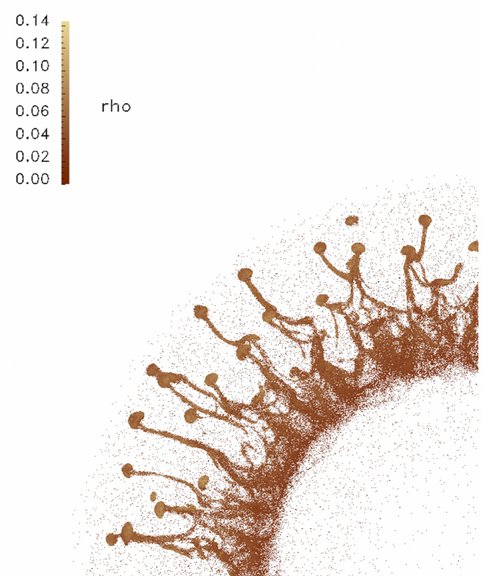2010 Annual Science Report
 Arizona State University
Reporting | SEP 2009 – AUG 2010
Arizona State University
Reporting | SEP 2009 – AUG 2010
Astrophysical Controls on the Elements of Life, Task 2: Model the Chemical and Dynamical Evolution of Massive Stars
Project Summary
Massive stars are the primary source for the elements heavier than hydrogen and helium on the periodic table. We are simulating the evolution of these stars and their eventual deaths in supernova explosions with state of the art physics in order to generate the most accurate estimates possible of the yields of chemical elements from both individual stars and stellar populations. We are also observing the variations of elemental abundances in nearby planet host candidates in order to determine the range of variation in bioessential elements and the effects of non-sunlike compositions on the evolution of the host stars.
Project Progress
Investigator Patrick Young and Graduate Student Carola Ellinger with support from outside collaborators have completed and published an analysis of the coproduction of isotopes in a 3D asymmetric explosion. Calculations of 3D explosions of further massive stars with 106 sph particles have been run to 50-100 years after the supernova explosion. These include explosions for spherical symmetry and four different asymmetric morphologies for two progenitor stars. We are performing a 5×107 particle simulation for both progenitors. We have applied for time of the Los Alamos Roadrunner system (currently #3 on the list of fastest supercomputers) to perform a 109 particle simulation on 24,000 processors. Our supernova code has been updated with an improved nuclear reaction network and cooling to model formation of the dense clumps that may participate in element injection. The efficiency of our large network post-processing code (500 – 3300 isotopes) has been substantially increased.
Investigator Frank Timmes and Graduate Student Georgios Maskotsios (with collaborators at multiple institutions) have published a study on the impact of experimentally determined nuclear rates and varying stellar and supernova conditions on the yield of heavy elements. The group has also performed a study of the impact of 12C+12C reaction rates on s-process yields.
In related research, Young and Graduate Student Mike Pagano received 600 spectra of nearby solar-type stars from the Carnegie Institution of Washington planet search to study element abundance variations and 3 nights of observing time on the Magellan Telescope in Chile to study element abundances in triggered star formation regions in the Scorpius-Centaurus stellar association, which has subgroups ranging in age from 5 – 15 million years, to provide estimates of how much material has been injected into forming stars by supernovae in older parts of the group. This will provide an estimate of the efficiency of incorporation of massive star yield into nearby forming stellar systems. Finally, Young is modeling the evolution of stars with element abundance ratios very different from solar to determine the impact of changed compositions on nucleosynthetic yields, evolution, and potential habitability.
Formation of structures ~20 hours after a supernova explosion in a slice through the x-z plane from a 50 million particle smooth particle hydrodynamics (sph) simulation. Colors indicate density. The high density clumps serve as the seeds of structures which could later deliver nucleosynthetic products to nearby areas of star and planet formation. Full nucleosynthesis calculations using the simulation data provide the element abundances for each “clump”.
Publications
-
Ellinger, C. I., Young, P. A., & Desch, S. J. (2010). COLLATERAL EFFECTS ON SOLAR NEBULA OXYGEN ISOTOPES DUE TO INJECTION OF 26 Al BY A NEARBY SUPERNOVA. The Astrophysical Journal, 725(2), 1495–1506. doi:10.1088/0004-637x/725/2/1495
-
Eriksen, K. A., Arnett, D., McCarthy, D. W., & Young, P. (2009). THE REDDENING TOWARD CASSIOPEIA A’s SUPERNOVA: CONSTRAINING THE 56 Ni YIELD. The Astrophysical Journal, 697(1), 29–36. doi:10.1088/0004-637x/697/1/29
-
Magkotsios, G., Timmes, F. X., Hungerford, A. L., Fryer, C. L., Young, P. A., & Wiescher, M. (2010). TRENDS IN 44 Ti AND 56 Ni FROM CORE-COLLAPSE SUPERNOVAE. The Astrophysical Journal Supplement Series, 191(1), 66–95. doi:10.1088/0067-0049/191/1/66
- Bennett, M.E., Hirschi, R., Pignatari, M., Diehl, S., Fryer, C.L., Herwig, F., Hungerford, A.L., Magkotsios, G., Rockefeller, G., Timmes, F.X., Wiescher, M. & Young, P.A. (2010). The effect of 12 C + 12 C rate uncertainties on s-process yields. Journal of Physics Conference Series, 202a: 2023.
- Young, P.A., Timmes, F.X. & Tr’Ehnl, N. (2010). The turbulent origin of the elements: dynamical/chemical evolution and explosions of massive stars and implications for Astrobiology. Lunar and Planetary Institute Contributions, 1538: 5395.
-
PROJECT INVESTIGATORS:
-
PROJECT MEMBERS:
Francis Timmes
Co-Investigator
Chris Fryer
Collaborator
Aimee Hungerford
Collaborator
Gabriel Rockefeller
Collaborator
Michael Wiescher
Collaborator
Themis Athanassiadou
Postdoc
Carola Ellinger
Graduate Student
Georgios Magkotsios
Graduate Student
Nahks Tr'Ehnl
Graduate Student
-
RELATED OBJECTIVES:
Objective 1.1
Formation and evolution of habitable planets.
Objective 3.1
Sources of prebiotic materials and catalysts


